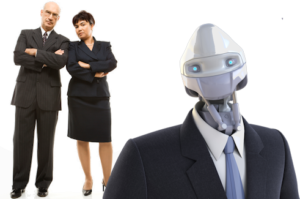At the 2014 World Economic Forum, Eric Schmidt, executive chairman of Google, stated, “The race is between computers and people and the people need to win. I am clearly on that side. In this fight, it is very important that we find the things that humans are really good at.” [“Google chief warns of IT threat,” by John Gapper and Richard Waters, Financial Times, 23 January 2014] You might think that a Google executive would be the last person to raise concerns about advances in technology. His concern, however, is focused more on how technology is affecting employment than it is on any inherent dangers involved with technology. Gapper and Waters explain:
“Mr Schmidt’s comments follow warnings from some economists that the spread of information technology is starting to have a deeper impact than previous periods of technological change and may have a permanent impact on employment levels. Google itself, which has 46,000 employees, has placed big bets on automation over some existing forms of human labour, with a series of acquisitions of robot start-ups late last year. Its high-profile work on driverless cars has also led to a race in the automobile industry to create vehicles that can operate without humans, adding to concerns that some classes of manual labour once thought to be beyond the reach of machines might eventually be automated. Recent advances in artificial intelligence and mobile communications have also fuelled fears that whole classes of clerical and research jobs may also be replaced by machines. While such upheaval has been made up for in the past by new types of work created by advancing technology, some economists have warned that the current pace of change is too fast for employment levels to adapt.”
As Stephen D. Simpson notes, “Unemployment is universally recognized as a bad thing.” [“The Cost Of Unemployment To The Economy,” Investopedia, 9 August 2011] He continues, “While economists and academics make convincing arguments that there is a certain natural level of unemployment that cannot be erased, elevated unemployment imposes significant costs on the individual, the society and the country.” One well-known concern involves unemployment among young people. There is perhaps nothing more potentially disruptive than having a large number of energetic young people who are frustrated (if not angry) at their inability to find work. That angst almost always results in unrest. Simpson explains some of the other negative consequences of unemployment on individuals, on societies, and on countries. Concerning the individual he writes:
“The costs of unemployment to the individual are not hard to imagine. When a person loses his or her job, there is often an immediate impact to that person’s standard of living. … Even for those eligible for unemployment benefits and other forms of government assistance (like food assistance), it is often the case that these benefits replace 50% or less of their regular income. That means these people are consuming far less than usual. The economic consequences can go beyond just less consumption, though. … Prolonged unemployment can lead to an erosion of skills, basically robbing the economy of otherwise useful talents. At the same time, the experience of unemployment (either direct or indirect) can alter how workers plan for their futures — prolonged unemployment can lead to greater skepticism and pessimism about the value of education and training and lead to workers being less willing to invest in the long years of training some jobs require. On a similar note, the absence of income created by unemployment can force families to deny educational opportunities to their children and deprive the economy of those future skills. Last but not least, there are other costs to the individual. Studies have shown that prolonged unemployment harms the mental health of workers, and can actually worsen physical health and shorten lifespans.”
Schmidt’s concern is that industry leaders will continue its push for greater efficiency without ever considering the ultimate consequences of such efforts (i.e., higher unemployment). Without simultaneous efforts to find jobs for displaced workers, unemployment rates could be so high that economies could collapse because there simply aren’t enough gainfully employed individuals to keep it growing. At that point, Simpson notes, politicians are apt to treat the symptoms rather than the causes of unemployment by increasing protectionism and imposing severe restrictions on immigration. “Protectionism can not only lead to destructive tit-for-tat retaliation among countries,” he writes, “but reductions in trade harm the economic well-being of all trading partners.” He continues:
“Other social costs include how people interact with each other. Studies have shown that times of elevated unemployment often correlate both with less volunteerism and higher crime. Elevated crime makes sense because absent a wage-paying job people may turn to crime to meet their economic needs or simply to alleviate boredom. The volunteerism decline does not have an obvious explanation, but could perhaps be tied to the negative psychological impacts of being jobless or perhaps even resentment at those who do not have a job.”
Simpson goes on to explain, “The economic costs of unemployment are probably more obvious when viewed through the lens of the national checkbook.” He reports that “unemployment leads to higher payments from state and federal governments for unemployment benefits, … food assistance, and Medicaid. At the same time, those governments are no longer collecting the same levels of income tax as before — forcing the government to borrow money (which defers the costs and impacts of unemployment into the future) or cut back on other spending (perhaps exacerbating the bad economic situation).” Schmidt believes that governments need “to encourage rapidly growing ‘gazelle’ companies to counter such trends and create new jobs” as well as “invest in education systems to improve skill levels and human cognition.” These actions would address the causes (rather than the symptoms) of unemployment. Derek Thompson agrees with analysts who insist that the new industrial revolution is different than those in the past. Driving this new revolution, he writes, “is an invisible force that goes by many names. Computerization. Automation. Artificial intelligence. Technology. Innovation. And, everyone’s favorite, ROBOTS.” [“What Jobs Will the Robots Take?” The Atlantic, 23 January 2014] He continues:
“Nearly half of American jobs today could be automated in ‘a decade or two,’ according to a new paper by Carl Benedikt Frey and Michael A. Osborne, discussed recently in The Economist. The question is: Which half? Another way of posing the same question is: Where do machines work better than people? Tractors are more powerful than farmers. Robotic arms are stronger and more tireless than assembly-line workers. But in the past 30 years, software and robots have thrived at replacing a particular kind of occupation: the average-wage, middle-skill, routine-heavy worker, especially in manufacturing and office admin. … The next wave of computer progress will continue to shred human work where it already has: manufacturing, administrative support, retail, and transportation.”
For anyone holding out hope that factory jobs are going to return the United States, Charles Kenny insists they need to be more realistic. [“Factory Jobs Are Gone. Get Over It,” Bloomberg BusinessWeek, 23 January 2014] He discusses how manufacturing jobs, like jobs in agriculture, have steadily declined for decades. He writes:
“According to the Bureau of Labor Statistics, the number of employees in manufacturing was 16 million in 1953 (about a third of total nonfarm employment), 19 million in 1980 (about a fifth of nonfarm employment), and 12 million in 2012 (about a tenth of nonfarm employment). Service industries — hotels, hospitals, media, and accounting — have taken up the slack. Even much of the value generated by U.S. manufacturing involves service work — about a third of the total. More than half of all people still employed in the U.S. manufacturing sector work in such services as management, technical support, and sales. Over the past 30 years, manufacturers have spent more on labor-saving machinery and hired fewer but more skilled workers to run it. From 1980 to 2012 across the whole economy, output per hour worked increased 85 percent. In manufacturing output per hour climbed 189 percent. The proportion of manufacturing workers with some college education has increased from one-fifth to one-half since 1969.”
Kenny calls this a “crisis of unemployment and inequality.” And he believes this crisis “demands a serious response. It is not a problem that a few high-tech manufacturing jobs can fix — however fancy the hubs are.” In the concluding part of this article, I’ll discuss some of the skills and traits that humans will need and the types of, jobs they likely fill in the future.




